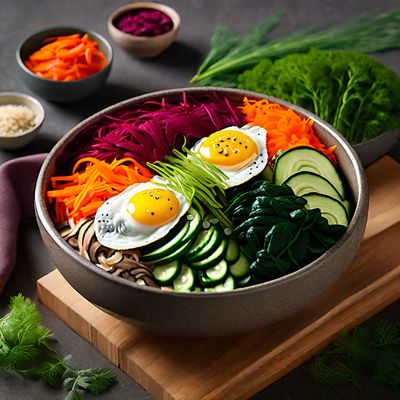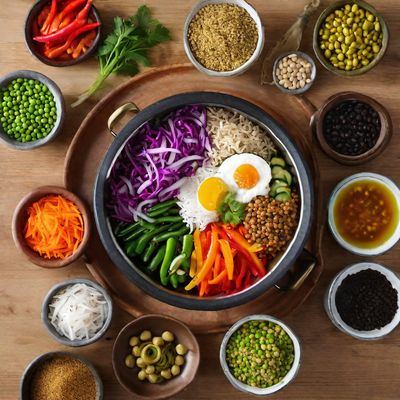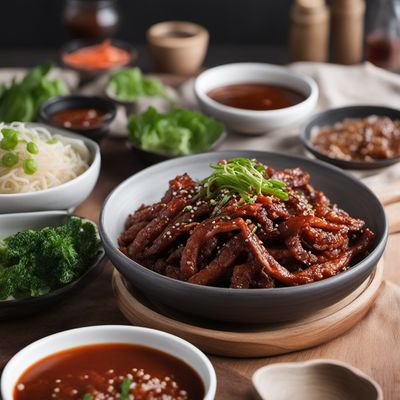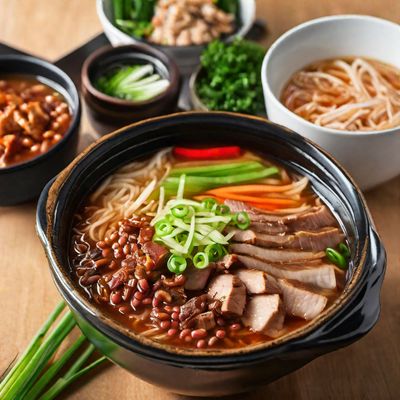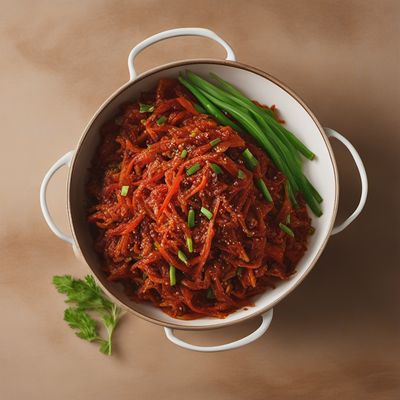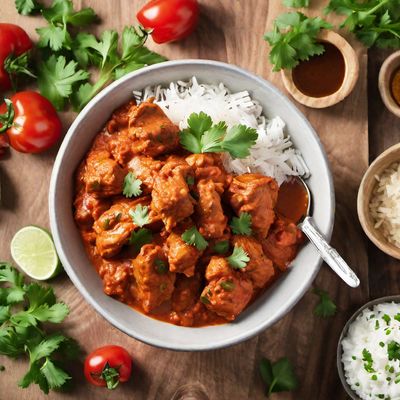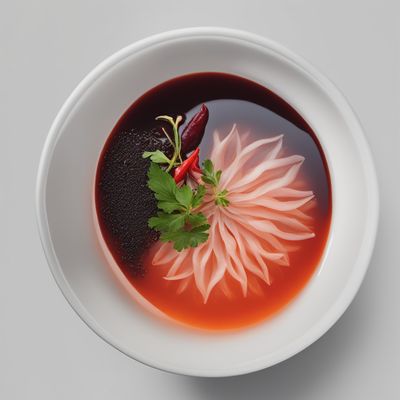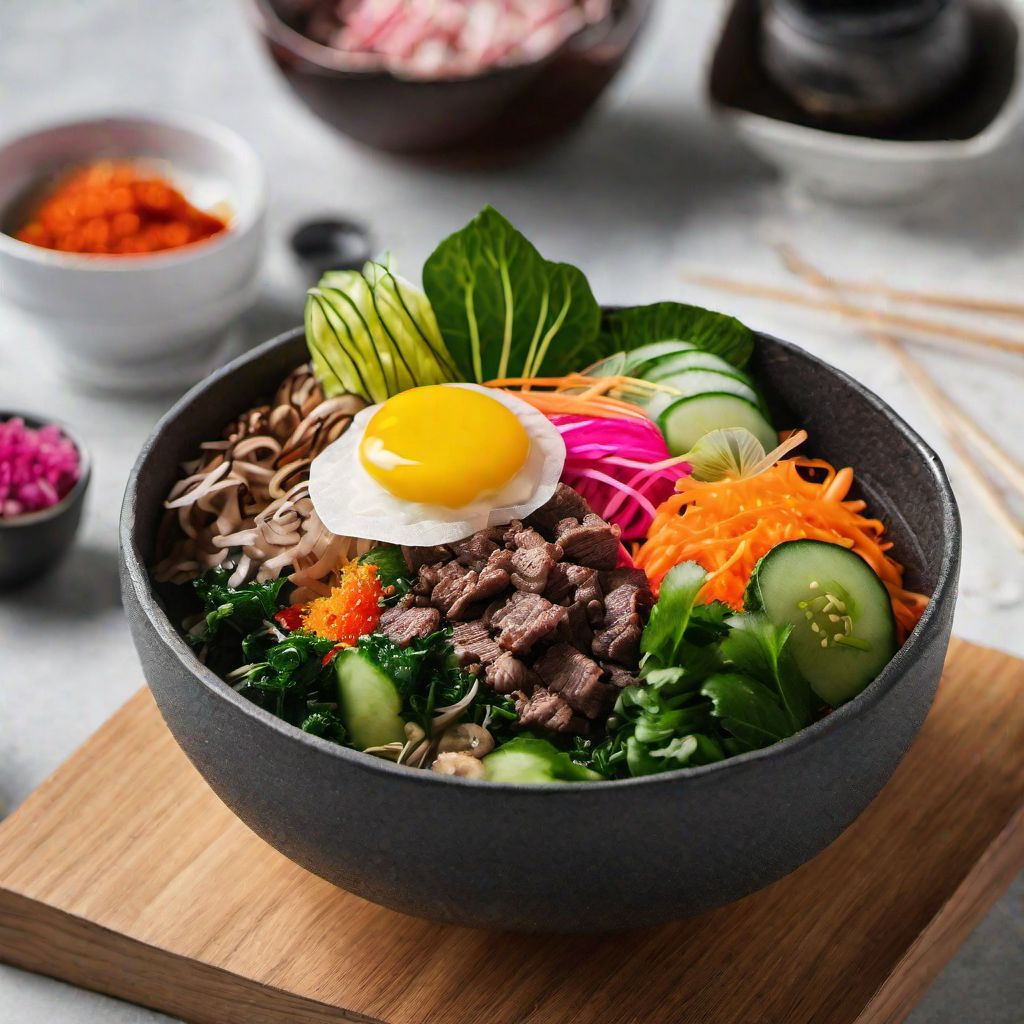
Recipe
Molecular Gastronomy Bibimbap
The Art of Molecular Bibimbap
4.8 out of 5
In the realm of molecular gastronomy, we reimagine the traditional Korean dish, Bibimbap. This avant-garde version combines science and culinary artistry to create a visually stunning and innovative dining experience. By deconstructing and reconstructing the elements of Bibimbap, we elevate its flavors and textures to new heights.
Metadata
Preparation time
120 minutes
Cooking time
10 minutes
Total time
130 minutes
Yields
4 servings
Preparation difficulty
Medium
Suitable for
Vegetarian, Gluten-free, Dairy-free, Nut-free, Vegan (if omitting the sous vide beef and egg yolk)
Allergens
Eggs, Sesame
Not suitable for
Paleo, Keto, Low-carb, High-protein, Raw food
Ingredients
In this molecular gastronomy adaptation, we transform the traditional Bibimbap into a visually captivating dish by utilizing techniques like spherification, foams, and gels. The focus is on presenting each component in a unique and unexpected way, while still maintaining the essence of the original flavors. We alse have the original recipe for Bibimbap, so you can check it out.
-
200g (7 oz) sous vide beef, thinly sliced 200g (7 oz) sous vide beef, thinly sliced
-
50g (1.8 oz) carrot gel 50g (1.8 oz) carrot gel
-
50g (1.8 oz) cucumber foam 50g (1.8 oz) cucumber foam
-
50g (1.8 oz) pickled radish spheres 50g (1.8 oz) pickled radish spheres
-
50g (1.8 oz) spinach powder 50g (1.8 oz) spinach powder
-
50g (1.8 oz) mushroom soil 50g (1.8 oz) mushroom soil
-
50g (1.8 oz) gochujang caviar 50g (1.8 oz) gochujang caviar
-
50g (1.8 oz) crispy rice paper 50g (1.8 oz) crispy rice paper
-
1 egg yolk 1 egg yolk
-
Sesame oil, for drizzling Sesame oil, for drizzling
-
Microgreens, for garnish Microgreens, for garnish
Nutrition
- Calories (kcal / KJ): 350 kcal / 1465 KJ
- Fat (total, saturated): 12g, 2g
- Carbohydrates (total, sugars): 45g, 10g
- Protein: 15g
- Fiber: 8g
- Salt: 2g
Preparation
-
1.Preheat a water bath to 55°C (131°F) for the sous vide beef.
-
2.Sous vide the beef for 2 hours until tender and perfectly cooked.
-
3.While the beef is cooking, prepare the carrot gel, cucumber foam, pickled radish spheres, spinach powder, mushroom soil, gochujang caviar, and crispy rice paper using molecular gastronomy techniques.
-
4.Once all the components are ready, assemble the dish by placing the sous vide beef slices in the center of the plate.
-
5.Arrange the carrot gel, cucumber foam, pickled radish spheres, spinach powder, mushroom soil, gochujang caviar, and crispy rice paper around the beef.
-
6.Carefully place the egg yolk on top of the beef.
-
7.Drizzle sesame oil over the dish and garnish with microgreens.
Treat your ingredients with care...
- Sous vide beef — For the best results, marinate the beef in a Korean-inspired marinade before vacuum-sealing and cooking sous vide.
- Carrot gel — Use a high-quality juicer to extract the carrot juice for a vibrant and smooth gel.
- Cucumber foam — Use a whipping siphon to create a light and airy foam by combining cucumber juice with a foaming agent.
- Pickled radish spheres — Use a reverse spherification technique to transform pickled radish juice into delicate spheres.
- Gochujang caviar — Utilize the basic spherification method to create small caviar-like spheres using gochujang sauce.
Tips & Tricks
- Experiment with different flavors and textures by incorporating other molecular gastronomy techniques such as gels, powders, and emulsions.
- Adjust the seasoning and spice level according to personal preference.
- Serve the dish immediately after assembly to preserve the integrity of the molecular components.
- Have fun with plating and presentation, as the visual aspect is a crucial element in molecular gastronomy.
- Feel free to explore alternative ingredients and molecular techniques to further enhance the dish.
Serving advice
Serve the Molecular Gastronomy Bibimbap as a main course, allowing guests to mix the components together to create a harmonious blend of flavors and textures. Encourage them to savor each bite and appreciate the artistry behind the dish.
Presentation advice
Present the dish on a sleek, minimalist plate to highlight the vibrant colors and intricate arrangement of the molecular components. Consider using a glass plate or a black slate for a modern and elegant presentation.
More recipes...
For Bibimbap » Browse all
For Korean cuisine » Browse all
More Korean cuisine dishes » Browse all
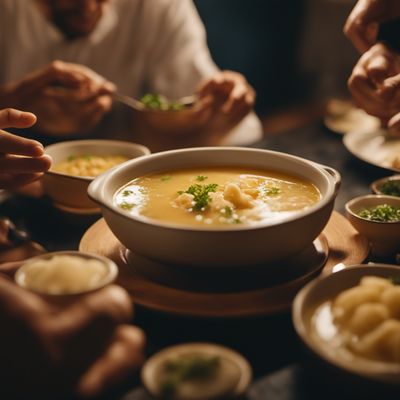
Sujebi
Hand-pulled dough soup
Sujebi is a Korean traditional soup made with hand-pulled dough flakes and vegetables. It is a popular comfort food in Korea, especially during...

Yugwa
Yugwa is a traditional Korean snack made from glutinous rice flour and honey. It is a popular snack during the Lunar New Year and other festive occasions.

Dubujeon
Dubujeon, or Korean pancake, is a savory dish that is perfect for breakfast, lunch, or dinner. The dish is simple to prepare and can be customized...

